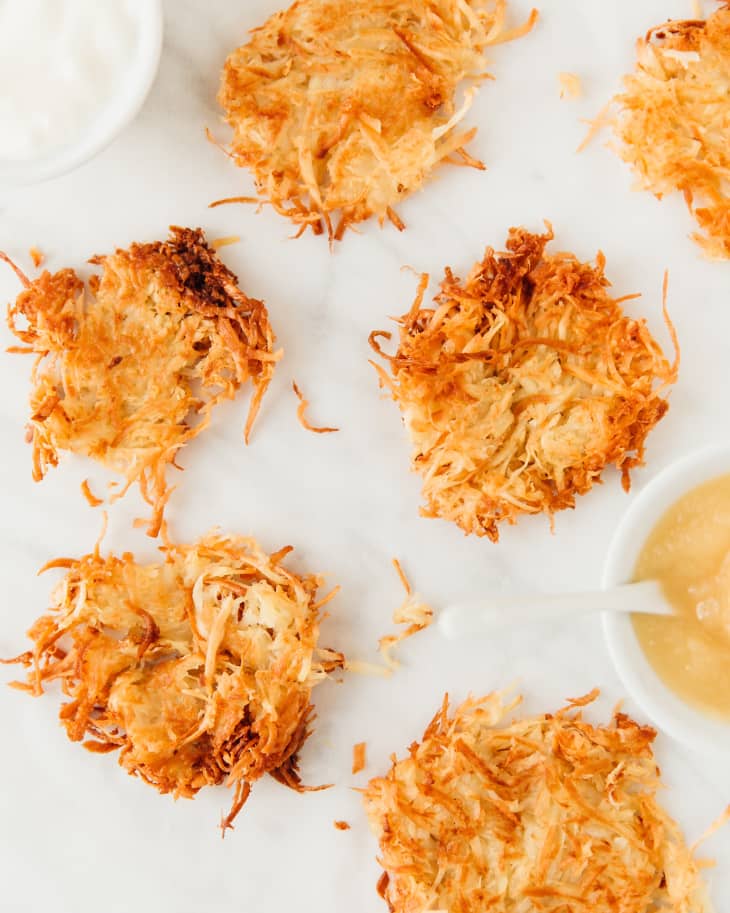Recipe: Crisp Parsnip Latkes

Parsnips — sweet, citrusy, spicy, and starchy — make a crazy-good latke. What? You thought latkes were only made from potatoes and only for Hanukkah? Let me explain.
The History of Latkes
Latkes — typically potato pancakes — are a traditional European side dish that the local Jewish (Ashkenazic) population adopted long ago as their Hanukkah treat. The potato’s not the key here; it’s the oil, which reminds us of the mythical bit of oil that miraculously kept the temple lamp lit for eight days after the victory of Judah and his band of Maccabees over Syrian-Greek rule.
Until recently, I’ve been firmly of the potato-latke persuasion, but then those velvety winter parsnips at the farmers market started calling my name. Their naturally complex flavors produce a sophisticated pancake, especially when finished with a squeeze of lemon to play up the root vegetable’s citrus notes. And, heretical as this may sound, I think their sweetness makes them an even better partner than potatoes to the customary applesauce accompaniment. They’re pretty terrific with crème fraîche, too.
How Parsnip Latkes Are Different from Potato Latkes
The main difference when using parsnips for latkes is that they don’t contain as much water as potatoes. Buy the juiciest-looking medium-sized parsnips you can (avoid those with cracks), but even the best ones may have large, woody cores. I’ve given a range for the number of eggs and amount of flour and baking powder in the recipe. Start by adding the lesser amount, and add the rest if the mixture looks very dry (it won’t hold together in the pan).
Tips for Frying Latkes
I may have become more broad-minded in my choice of roots, but I never waver from the holy trinity of great latkes: Make them very thin so they cook all the way through before the outside burns (and I do mean thin — one tablespoon of latke batter flattened with a spoon makes a three- to four-inch pancake); don’t use too much oil (not more than 1/4 inch at a time, so you pan-fry instead of deep-fry); and keep the oil hot enough, over medium heat, so the batter sizzles on contact.
Whether or not you celebrate Hanukkah, the Festival of Lights, enjoy parsnip latkes throughout the winter and spring, when the roots are at their sweetest. Parsnip latkes are delicious with roasted or braised meats and poultry, and are exciting enough to make a compelling meatless center of the plate.
This recipe is adapted from the traditional one my family has been using for three generations, inspired by the one in Sara Kasden’s hilarious 1956 cookbook, Love and Knishes. Best of all, the recipe is easily doubled or tripled. Because who can eat just one latke?
Testing Notes
This is a really great twist on traditional potato latkes. Underrated parsnips get their turn in the spotlight and yield sweet, tasty results. Parsnips don’t have as much starch as potatoes, so it’s nice that you can skip the step of squeezing any excess liquid out. Using the food processor to grate the parsnip and onions made getting the batter together a cinch.
– Christine, December 2015
Parsnip Latkes
Makes 24 latkes
Serves 6
Nutritional Info
Ingredients
- 2 pounds
(900 grams) medium to large parsnips, peeled
- 1
small onion
- 2 to 4
heaping tablespoons unbleached all-purpose flour or potato starch
- 1 teaspoon
kosher salt
- 1/2 teaspoon
baking powder
Freshly ground white pepper
- 2 to 4
large eggs, lightly beaten
Mild oil with a medium-high smoke point, such as grapeseed, sunflower, or avocado, for pan-frying
Coarse finishing salt, such as Maldon sea salt
- 1
lemon
Optional accompaniments: applesauce, roasted smashed apples and pears and/or crème fraîche
Instructions
Using the large holes of a box grater or a food processor fitted with the grating disk, grate the parsnips. You should have about 5 cups (730 grams). The parsnips may discolor slightly as they stand, but don’t worry. Grate the onion on the large holes of the box grater or fit the processor with the metal S blade and grate. It should look like pulp; mince or discard any large onion pieces.
In a large bowl, stir together parsnips, onion, 2 heaping tablespoons flour, salt, 1/2 teaspoon baking powder, and a few grinds of pepper. Stir in 2 eggs. If the mixture seems dry, add the remaining flour, baking powder, and eggs.
Line 2 or 3 sheet pans with paper towels. Place the prepared pans, the latke batter, a large spoon, and a spatula near the stove. Heat 1 or 2 large skillets over medium heat. Generously film the skillet(s) with oil (not more than 1/4-inch/6 millimeters deep). When the oil is shimmering and a tiny bit of batter sizzles on contact, start spooning in the latke batter, making sure to add both solids and liquid. Using the back of the spoon, flatten each spoonful into a circle 3 to 4 inches (7.5 to 10 centimeters) in diameter. Do not crowd the latkes in the pan. You'll get 4 or 5 latkes in a 12-inch (30.5-centimeter) skillet.
Cook the latkes, flipping them once, until golden on both sides, 5 to 6 minutes total. Transfer the latkes to a prepared baking sheet. Cook the remaining batter in the same way, stirring the batter before adding more to the pan and adding oil as needed at the edge of the pan.
Arrange the latkes on a warmed platter, sprinkle with finishing salt, and add a squeeze of lemon over all. Serve with applesauce, roasted fruit, or crème fraîche as desired.
Recipe Notes
Reprinted with permission from The Seasonal Jewish Kitchen by Amelia Saltsman, copyright (c) 2015. Published by Sterling Epicure, an imprint of Sterling Publishing Co., Inc.
